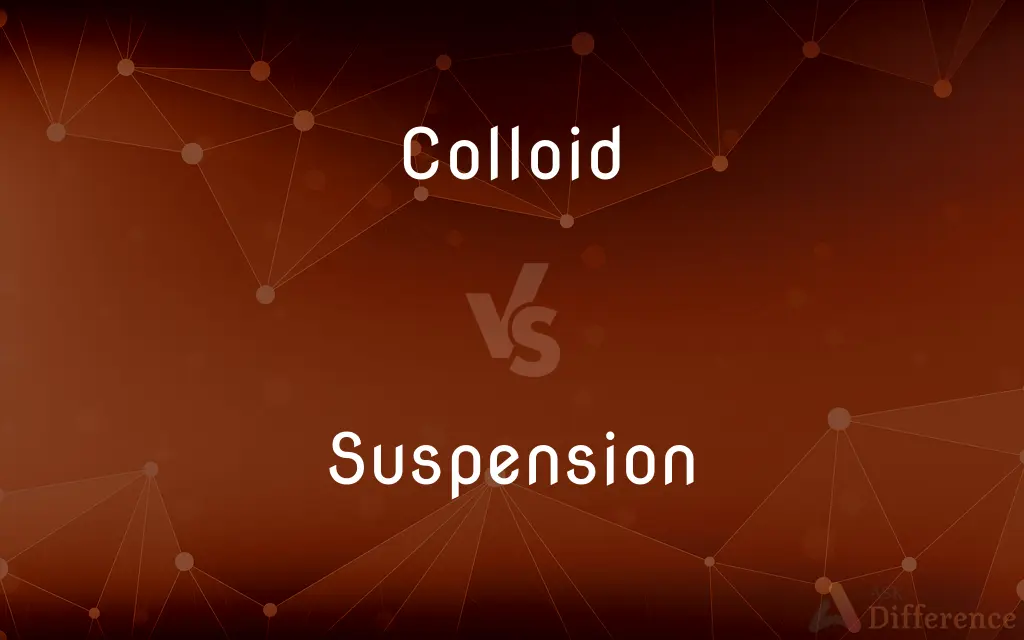Colloid vs. Suspension — What's the Difference?
By Tayyaba Rehman & Fiza Rafique — Updated on April 18, 2024
Colloids have particles sized between 1 and 1000 nanometers, forming mixtures that are stable and don't settle, while suspensions contain larger particles that can settle over time.

Difference Between Colloid and Suspension
Table of Contents
ADVERTISEMENT
Key Differences
Colloids are mixtures where the particle size ranges from 1 to 1000 nanometers, which are small enough to remain evenly distributed without settling. Whereas, suspensions are heterogeneous mixtures containing larger particles that are visible to the naked eye and can settle out over time.
In colloids, the dispersed particles do not settle because of their small size and interaction with the dispersion medium, which often includes electrostatic forces. On the other hand, particles in a suspension are typically larger than 1000 nanometers and due to gravity, can settle out unless continuously agitated.
The appearance of colloids can be translucent or opaque due to the Tyndall effect, where light is scattered by the particles in the colloid. In contrast, suspensions often appear cloudy or murky and become clear upon settling as the particles precipitate.
Colloids are quite stable due to the small size of the dispersed particles and their chemical interactions with the medium. Suspensions, however, require mechanical agitation to remain mixed and tend to separate into layers over time.
Examples of colloids include milk, mayonnaise, and fog, where the properties of the mixture are consistent throughout. Suspensions include mixtures like sand in water or flour in water, where the particles are noticeably separate and can be easily filtered.
ADVERTISEMENT
Comparison Chart
Particle Size
1 to 1000 nanometers
Larger than 1000 nanometers
Visibility
Particles not visible
Particles visible to naked eye
Stability
Stable, do not settle
Settle over time
Light Scattering
Exhibit Tyndall effect
May or may not show Tyndall effect
Example
Mayonnaise, smoke
Muddy water, calamine lotion
Compare with Definitions
Colloid
Often stable due to the interactions between dispersed particles and the medium.
Mayonnaise remains stable as a colloid of oil in water.
Suspension
Can often be separated by physical means like filtration.
A sand and water mixture can be separated through a fine sieve.
Colloid
Typically opaque or translucent due to the Tyndall effect, where light scatters.
Fog scatters streetlights due to its colloidal properties.
Suspension
Must be continuously agitated to remain effective and mixed.
Paint is a suspension that must be stirred before use.
Colloid
Can be classified based on the phase of dispersed particles and dispersion medium (solid, liquid, gas).
Foam is a colloid of gas in liquid.
Suspension
Particles are larger and more visible compared to colloids.
Muddy water is a clear example of a suspension.
Colloid
Does not settle on standing and cannot be separated by filtration.
Gelatin, a colloid, remains evenly distributed without settling.
Suspension
A heterogeneous mixture in which solute-like particles settle out after suspension.
Particles of sand settle when mixed in water.
Colloid
A mixture where one substance is microscopically dispersed uniformly throughout another.
Blood is a colloid where cells are dispersed in plasma.
Suspension
Examples include pharmaceutical suspensions and natural sediments.
Calamine lotion is a suspension used for soothing the skin.
Colloid
A colloid is a mixture in which one substance of microscopically dispersed insoluble particles are suspended throughout another substance. However, some definitions specify that the particles must be dispersed in a liquid, and others extend the definition to include substances like aerosols and gels.
Suspension
An interruption or temporary cessation, as of an activity or of the application of a rule or law.
Colloid
A system in which finely divided particles, which are approximately 1 to 1,000 millimicrons in size, are dispersed within a continuous medium in a manner that prevents them from being filtered easily or settled rapidly.
Suspension
A temporary prohibition or exclusion, as from attending school or enjoying a privilege, especially as a punishment.
Colloid
The particulate matter so dispersed.
Suspension
A postponement, as of a judgment, opinion, or decision.
Colloid
The gelatinous stored secretion of the thyroid gland, consisting mainly of thyroglobulin.
Suspension
The prolongation of one or more tones of a chord into a following chord to create a temporary dissonance.
Colloid
Gelatinous material resulting from degeneration in diseased tissue.
Suspension
The tone or tones so prolonged.
Colloid
Of, relating to, containing, or having the nature of a colloid.
Suspension
A device from which a mechanical part is suspended.
Colloid
Glue-like; gelatinous.
Colloid tumours
Suspension
The system of springs and other devices that insulates the chassis of a vehicle from shocks transmitted through the wheels.
Colloid
(chemistry) A stable system of two phases, one of which is dispersed in the other in the form of very small droplets or particles.
Suspension
(Chemistry) A system in which minute particles are dispersed throughout a fluid from which they are easily filtered but not easily settled because of system viscosity or molecular interactions.
Colloid
(meteorology) An intimate mixture of two substances, one of which, called the dispersed phase (or colloid), is uniformly distributed in a finely divided state throughout the second substance, called the dispersion medium (or dispersing medium).
Suspension
The act of suspending, or the state of being suspended.
Suspension from a hook
Colloid
(geology) A particle less than 1 micron in diameter, following the Wentworth scale
Suspension
A temporary or conditional delay, interruption or discontinuation.
Colloid
Resembling glue or jelly; characterized by a jellylike appearance; gelatinous; as, colloid tumors.
Suspension
The state of a solid or substance produced when its particles are mixed with, but not dissolved in, a fluid, and are capable of separation by straining.
Colloid
A substance (as albumin, gum, gelatin, etc.) which is of a gelatinous rather than a crystalline nature, and which diffuses itself through animal membranes or vegetable parchment more slowly than crystalloids do; - opposed to crystalloid.
Suspension
Thus a kind of silt or sludge.
Colloid
A gelatinous substance found in colloid degeneration and colloid cancer.
Suspension
The act of keeping a person who is listening in doubt and expectation of what is to follow.
Colloid
A mixture with properties between those of a solution and fine suspension
Suspension
The temporary barring of a person from a workplace, society, etc. pending investigation into alleged misconduct.
Suspension
(education) The process of barring a student from school grounds as a form of punishment (particularly out-of-school suspension).
Suspension from school as a disciplinary measure
Suspension
(music) The act of or discord produced by prolonging one or more tones of a chord into the chord which follows, thus producing a momentary discord, suspending the concord which the ear expects.
Suspension
A stay or postponement of the execution of a sentence, usually by letters of suspension granted on application to the Lord Ordinary.
Suspension
(topology) A topological space derived from another by taking the product of the original space with an interval and collapsing each end of the product to a point.
Suspension
(topology) A function derived, in a standard way, from another, such that the instant function’s domain and codomain are suspensions of the original function’s.
Suspension
(vehicle) The system of springs and shock absorbers connected to the wheels in an automobile, which allows the vehicle to move smoothly with reduced shock to its occupants.
Suspension
The act of suspending, or the state of being suspended; pendency; as, suspension from a hook.
Suspension
Especially, temporary delay, interruption, or cessation
Suspension
A conditional withholding, interruption, or delay; as, the suspension of a payment on the performance of a condition.
Suspension
The state of a solid when its particles are mixed with, but undissolved in, a fluid, and are capable of separation by straining; also, any substance in this state.
Suspension
A keeping of the hearer in doubt and in attentive expectation of what is to follow, or of what is to be the inference or conclusion from the arguments or observations employed.
Suspension
A stay or postponement of execution of a sentence condemnatory by means of letters of suspension granted on application to the lord ordinary.
Suspension
The prolongation of one or more tones of a chord into the chord which follows, thus producing a momentary discord, suspending the concord which the ear expects. Cf. Retardation.
Suspension
A mixture in which fine particles are suspended in a fluid where they are supported by buoyancy
Suspension
A time interval during which there is a temporary cessation of something
Suspension
Temporary cessation or suspension
Suspension
An interruption in the intensity or amount of something
Suspension
A mechanical system of springs or shock absorbers connecting the wheels and axles to the chassis of a wheeled vehicle
Suspension
The act of suspending something (hanging it from above so it moves freely);
There was a small ceremony for the hanging of the portrait
Suspension
A temporary debarment (from a privilege or position etc)
Common Curiosities
How do the stability properties differ between colloids and suspensions?
Colloids are stable and do not settle, whereas suspensions can settle over time unless agitated.
Do all colloids exhibit the Tyndall effect?
Most colloids show the Tyndall effect due to light scattering by small particles, but not all.
What are practical examples of colloids and suspensions?
Practical examples include mayonnaise (colloid) and muddy water (suspension).
What defines the particle size in a colloid vs. a suspension?
In colloids, particles range from 1 to 1000 nanometers. In suspensions, they exceed 1000 nanometers.
What are some common uses of colloids in everyday life?
Colloids are widely used in everyday life, including in foods like jellies and ice cream, in cosmetics like lotions and creams, and in medical applications such as intravenous fluids and vaccines.
Can colloids be filtered using regular methods?
No, colloids cannot be separated by standard filtration; they require ultrafiltration or similar methods.
Can the Tyndall effect be used to differentiate between a colloid and a suspension?
Yes, the Tyndall effect can be a useful indicator to differentiate between colloids and suspensions. Colloids typically exhibit the Tyndall effect where light scatters by the smaller particles. Suspensions may not consistently show this effect due to the larger size of their particles.
Are suspensions considered unstable mixtures? Why or why not?
Suspensions are considered unstable mixtures because they tend to separate into their individual components over time. The settling of particles in suspensions occurs due to gravitational forces overwhelming the kinetic energy of the particles, leading to sedimentation.
Why do colloids not settle, unlike suspensions?
Colloids remain stable and do not settle due to the small size of their particles and their electrostatic or steric stabilization, which prevents the particles from aggregating. In contrast, the larger particles in suspensions are influenced by gravity and settle over time unless agitated.
How does particle interaction differ in colloids compared to suspensions?
In colloids, particles often have surface charges or coatings that cause them to repel each other, maintaining a stable, dispersed state. In suspensions, the larger particles lack these interactions and are more likely to clump together and settle.
Share Your Discovery

Previous Comparison
Specialist vs. Generalist
Next Comparison
Balcony vs. MezzanineAuthor Spotlight
Written by
Tayyaba RehmanTayyaba Rehman is a distinguished writer, currently serving as a primary contributor to askdifference.com. As a researcher in semantics and etymology, Tayyaba's passion for the complexity of languages and their distinctions has found a perfect home on the platform. Tayyaba delves into the intricacies of language, distinguishing between commonly confused words and phrases, thereby providing clarity for readers worldwide.
Co-written by
Fiza RafiqueFiza Rafique is a skilled content writer at AskDifference.com, where she meticulously refines and enhances written pieces. Drawing from her vast editorial expertise, Fiza ensures clarity, accuracy, and precision in every article. Passionate about language, she continually seeks to elevate the quality of content for readers worldwide.
















































